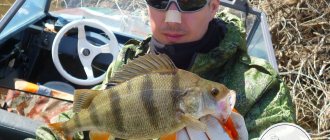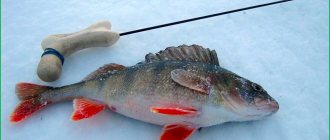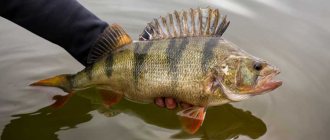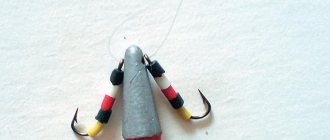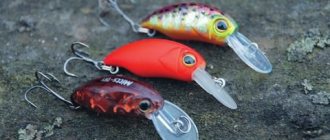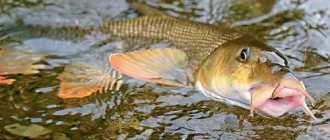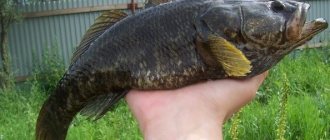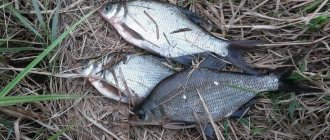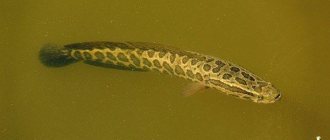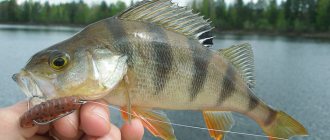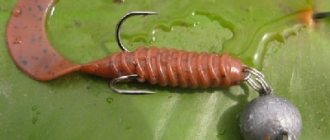Predator behavior in January
With the formation of a thick layer of ice, perches do not scour the entire water area of the reservoir in search of easy prey. They gather in small schools and stay close to the bottom.
The lower layers of water are less cold. There the temperature is constant - about + 4° C. And since fish are not warm-blooded animals, their body temperature directly depends on the temperature of the water and affects life processes: metabolism and metabolism. The colder the water, the slower the body absorbs the oxygen and food necessary for life. In addition, fish, being in austerity mode, need water saturated with oxygen in order to spend less energy on breathing.
Therefore, in January, the lack of oxygen in the water layers and the drop in temperature force the perch to lie in the pits almost motionless. But short feeding trips occur from time to time. Although the perch does not go far from its winter rookery. He does not want to leave his habitable place for the reason that he does not have the strength to make long journeys.
Where to look for perch in January
Upon arrival at the reservoir, you should look around and determine the wintering place of the perch. First, start fishing the coastal zone.
You should not look for perches where there were thickets of underwater grass in the summer. In these areas there is very little oxygen; rotting algae saturates the water with methane, which is unsuitable for breathing, and oxygen is taken from the water.
If there is enough oxygen in the water and the temperature is not lower than + 5°C, the prickly predator hunts close to the shore. It lies in ambush next to the reeds, at changes in depth and in places with cliffs and a hard bottom. At temperatures below five degrees, there is a chance to find perch at depth: in holes and other bottom depressions.
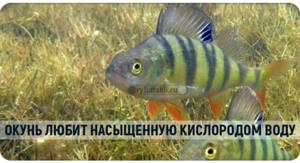
On a pond or lake, try fishing in places where a stream flows into the reservoir or underground springs flow. As a rule, perch always strive for fresh sources - they contain a large amount of oxygen.
Roach fishing in January
Roach reacts responsively not only to the onset of deep winter conditions, but also to the slightest change in weather. Its bite directly depends on the amount of oxygen in the water. It is best to look for roach in familiar places with depths of up to four meters - where you have caught it before. If the reservoir is unfamiliar and there is no one to consult about fishing spots, then it is worth walking a little on the ice to look for frozen or fresh holes. Where there will be the most of them, you should try to catch them.
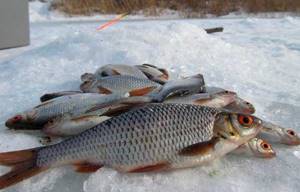
They catch roach using a jig or a float. In both cases, it is better to use bait - purchased or homemade (crackers + coconut flakes + milk powder + flavorings). It would be nice if you add a little live food to the bait - bloodworms, chopped worms, daphnia from aquarium fish food. Read also: About catching roach in January
Dough, bread, mash are used as bait, but still the best bait in January is considered to be bait of animal origin - bloodworms, maggots, worms, all kinds of larvae. If the bite is active, then you can try fishing with a reelless bait, tying a “devil” or “goat” to the line, but even in this case it is better to hook a red bloodworm.
Wonderful quiet day and great bite
Features and subtleties of perch fishing in January
When going perch fishing in January, you need to take into account the weather conditions. It is better to fish on a windless January day with a slight frost. When the atmospheric pressure is constant, the predator is more active than in bad weather. The most promising time for catching a predator is thaw. At this time, he is more active than ever in January.
During the day, the intensity of the striped predator's bite may change. Sometimes he bites better in the morning, sometimes in the middle of the day or in the late afternoon.
When fishing, do not forget about the holes that were drilled first. Perhaps after a while there will be a perch under them. Therefore, it is worth returning to them. A few movements with a jig or spinner will not take much time, and the result may be positive.
In the middle of winter, in order to tempt an inactive predator to bite, you can experiment with lures. Instead of the classic game with a jig, it is worth offering the striped robber other options: tapping and moving along the bottom, slowly raising the spoon with long pauses. There is no need to make sudden movements with the tackle, as the January perch is sluggish and cautious. This may scare him away and he will leave the fishing area.
The most catchy jigs for perch in the middle of nowhere
Sometimes you have to have up to a dozen equipped fishing rods on hand so as not to have to tie jigs on a pond. In the dead of winter, the fish are capricious and cautious; you should use the thinnest gear : fishing line from 0.07 mm and light jigs. It is worth noting that the thinner the line, the less it sails in the current. This allows you to use a lighter jig and better convey its action. There is a discussion going on on our forum in which experienced fishermen are discussing which types of jigs are best to use for catching perch.
Mothless
Many people believe that the largest specimens are caught using the “reelless” bait. Well, not counting, of course, balancers and other interpretations of the fry, about which, by the way, we recently wrote a comprehensive article.
It is during the deep winter period , when the fish does not want to feed heavily, that fishing with a reelless reel will be more successful than with balancers or spoons. It is easier to swing a passive perch and provoke it to bite with small bait. Correct monotonous play awakens the attacking instinct in the perch.
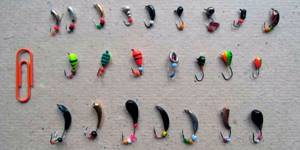
Before mastering this type of fishing, you should understand the following:
- You will be required to make precise rhythmic monotonous micro-oscillations. Not every person is able to engage in “mormod masturbation” for a long time. Well-established, correct technique directly affects the bite.
- You won't be able to wear warm gloves for precise work with bait. Hands should not be afraid of frost. Not everyone has the same blood circulation and sensitivity to cold. Think about it.
- Fishing with a reelless bait means actively moving around a body of water, from hole to hole, and a lot of drilling. Which is also not suitable for everyone’s temperament, and physically it’s not easy.
- Taking “strong drinks” does not fit with precise coordination of movements when working with such thin gear.
If this doesn’t scare you, then all that remains is to assemble the tackle and learn how to wire it correctly.
For this fishing, light balalaika fishing rods are most often used, although this is not for everyone. Equipped with fishing line 0.08-0.12 mm. The lavsan nod should be selected so that it bends 30-45 degrees under the weight of the jig.
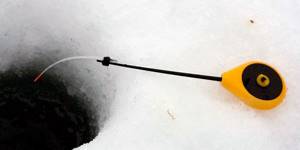
However, we will not focus on the details. We have already told you how to properly equip a “mothless” machine. To help the beginning “penguin”, we recommend that you watch the video of our Siberian Grigory Bezmenov. He talks in detail about a beginner’s kit for mastering reelless equipment: where to start, what to buy first. Very informative!
After that, all that remains is to study the fishing technique. You can tell a lot, but it’s better to show it once. This video clearly demonstrates the basic skills that are worth acquiring. And also, a universal, most catchy jig, with which it is better to start your first acquaintance.
Of course, if you have experienced friends who have been practicing this interesting type of fishing for a long time, follow their tail; during the fishing process, learning will be more fruitful.
“Mothless” are divided into types:
- "Devil";
- "Balda";
- "Goat";
- “Nymph”, this includes jigs of such types as “Uralka”, “Ant”, “Dreissena”, etc.
, “nail cube/nail ball” has been gaining popularity . If you haven’t tried fishing with it yet, we recommend it. This is one of the popular jigs, as shown by the voting in the topic: “Rating of the best jig for perch in 2021.”
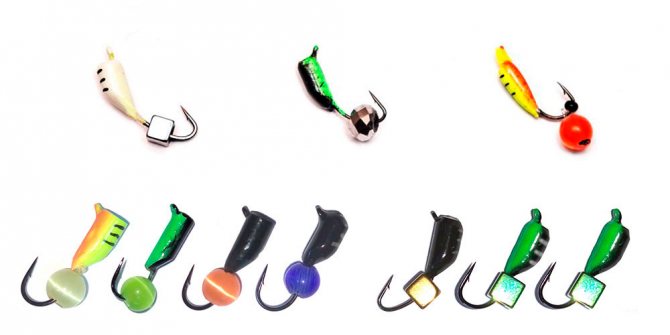
The topic of fishing with reelless rigs is vast and inexhaustible; some gurus could talk about it forever. Interested in learning about fishing at a more advanced level? We have excellent material where the author describes the technique for all of the above “mothless” tools. You can only understand the nuances of feeding each individual jig with experience. It's never too late to learn!
Mormyshka with nozzle
Often when fishing in the “dead season” you have to experiment - without this you won’t catch a single tail. There are days when a striped fish cannot be tempted by anything other than natural bait. Then the classic, old-fashioned method of extraction comes to the rescue.
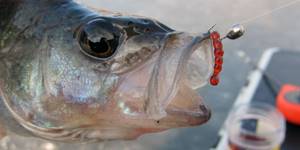
Perch loves an active, shaking, high-frequency game, often with tapping on the six of the fishing rod . When fishing with a jig with a bait, you should use bait responsibly. To attract perch, a feeding bloodworm or jig is suitable. If fishing involves working at relatively large depths, use feeders.
Nikita Dupin , a candidate master in fishing, a prize-winner and winner of many tournaments, will tell you more about this
The tackle should be thin and sensitive, especially the nod. We show you how to make one yourself from keyboard film on our channel.
To relieve the itch in your hands, if nothing else bites, you can catch small, sporty bass in almost any weather, even the most terrible.
What gear to use to catch perch in the middle of winter
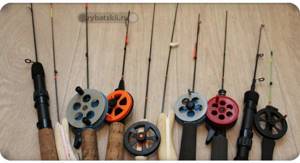
Lures for perch fishing in January determine the choice of fishing gear. Catching jigs for perch, regular and baitless, require a winter fishing rod of the “filly” or “balalaika” type equipped with a reel. The reel can be built into the rod, which gives fishing some comfort.
A nod made of lavsan or metal can be used as a bite alarm. Its length should not be more than five to six centimeters. The fishing line is usually selected according to the expected size of the object being fished. Winter perches weighing up to two hundred and fifty grams do not offer strong resistance. For fishing them, a fishing line with a thickness of 0.06 or 0.08 mm is suitable; for larger ones, the thickness can be increased to 0.10 or 0.12 millimeters.
For fishing with spinners, you need winter hard rods with a nod-spring or a rubber signaling device made from a nipple. Some amateur fishermen prefer to fish with sensitive spinning rods up to one meter long. This gear is designed for ice fishing. It uses a 0.16 mm fishing line, since it is supposed to catch large perch. There are also fans of winter fishing who, instead of monofilament, successfully use braided cord 0.06 millimeters thick in such fishing rods. It is highly sensitive - the angler feels even light bites from a half-asleep perch.
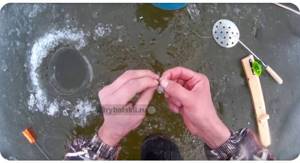
In addition to active fishing with jigs and spoons, hunting for freshwater predators can also be carried out passively. To do this, they use a well-known tackle - a girder. It is somewhat different from the pike: it does not have a metal leash and the hook is much smaller in size. The baits are designed for catching large perches, the so-called humpbacks. Small minnows and bleaks are usually used as live bait, which large perches can swallow whole.
Tackle for catching perch in winter
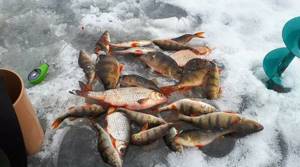
In winter you can fish with jigs, balance beams and spoons, less often with jigs. Bloodworms, caddisfly larvae, and maggots are used as bait. If there is a good bite, then some anglers catch by eye a perch that has already been caught before. As for fishing with lures, in cloudy weather it is worth using silver and white colors, and in sunny weather - brass or copper.
The gear should be the following: a regular fishing rod, thin fishing line, no more than 0.2 mm, a silver or yellow jig and a winter float. For trolling, use a standard live bait fishing rod.
Fish promising places, watch the actions of other anglers, look for places where you have already fished and you will definitely end up with some catch.
Read! On eriki for large roach
What to catch perch in January
In January, a special approach to fishing is needed, and therefore we will consider the nuances of fishing for perch during this period with different baits.
Jigs
To successfully catch perch in the middle of winter, you can use jigs with or without bloodworms. Among jigs with a natural attachment, the most popular are tackles in the form of a drop, a pellet, or a curved pellet called a “uralochka”. They work equally successfully depending on the appetizing nature of the bait attached to them. In this capacity, you can use maggots, pieces of earthworm, dragonfly larvae, poultry meat, fish fins and eyes and, of course, fresh bloodworms.
The second group includes various shaped jigs without a reel for perch, called goats, devils, witches, and all kinds of nail balls and nail cubes.
Fishing for perch in January with a jig requires the use of a special game. The movements should be smoother and less frequent, the more passive the striped predator behaves. It is important to be able to choose a jig game that will attract fish and force them to grab the bait.
The material used to make jigs is lead or tungsten. Tungsten jigs are more in demand among fishermen, since, compared to lead ones, their weight is less and the same size. This gives them smooth movement in the aquatic environment. For standing water at shallow depths, jigs weighing from two to three grams are suitable, for flowing water - heavier ones.
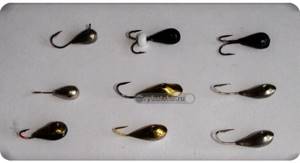
The color of the jig should be golden, black or silver. Such colors more often provoke perch to swallow the bait.
Spoons
Usually experienced anglers who are not interested in small perch catch perch using lures in the middle of winter. In winter, small fish do not hunt for large objects of food. Therefore, only large predators fall for the lure. For such fishing, spinners from one and a half to five centimeters long are used. They can be copper, brass and even silver. The tee of the spinner is decorated with a bunch of bright threads, multi-colored beads or cambrics.
In order for the spinner to play better horizontally, its center of gravity must be in the middle, and it itself must be wide. When fishing in pits, it is more advisable to use narrow spoons with a shifted center of gravity downwards. The so-called “maropeds” or “carnations”. This lure is better suited for vertical trolling at depth.
Balancers
A balancer is a bait that imitates the shape and movements of a fish. Its size depends on the size of the predator being caught - the larger the perch in the reservoir, the larger the balancer should be. Basically, baits with a length of two to five centimeters are used. The color, if perch fishing occurs at shallow depths, should correspond to the natural color of the simulated fish; if fishing at depth, it should be a bright acid color.
Rattlins
Rattlins are bladeless wobblers. They allow you to experiment with bait play, since there are several (usually three) attachment points on their back. Rattlins are used when catching large perch, because they were originally designed for catching not perch, but pike perch. You can also catch perch using amphipods from the ice, and this bait shows good results in the middle of winter.
Perch fishing in December
Perch fishing this month is particularly stable. This is a period when the first ice is just appearing on some reservoirs, which in itself implies high fish activity. On other bodies of water, the ice has been holding for a long time, the heat has passed, but there is still every chance of a good catch.
There is an opinion among anglers that after the period of first ice, the perch bite declines, but this is not the case. The fish simply take their usual wintering places, where they also continue to feed.
Therefore, for the most part, attention should be paid not to searching throughout the entire reservoir, but to targeted fishing of promising places.
Bait for a predator
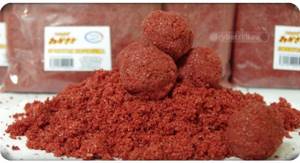
You need to feed perch in January where it has shown at least some activity. The purpose of this action is to collect more fish near the hole and force it to start feeding. You shouldn’t throw a lot of food into the hole: just a pinch of some tasty bait is enough.
On reservoirs with a current, you can place the mixture in a feeder and secure it to the bottom above the fishing spot. The calculation is simple - the bait will be washed out and a feeding area will be formed in the place where the lure is cast.
As winter bait for perch, you can use ready-made mixtures purchased in stores, homemade bait with the addition of bloodworms or animal ingredients, a jar of fry lowered to the bottom, a punctured rubber glove filled with blood, and much more.
